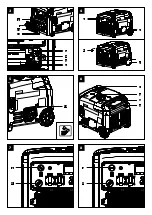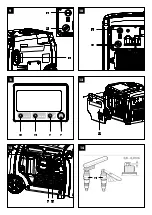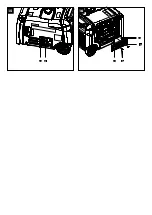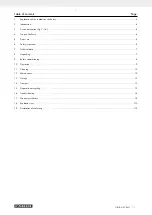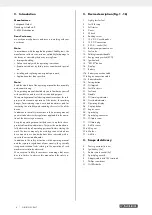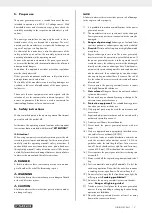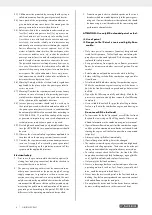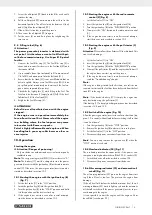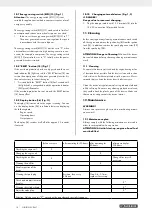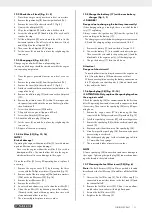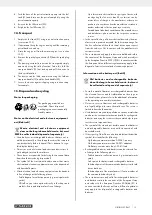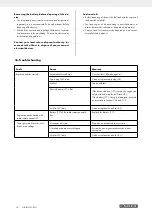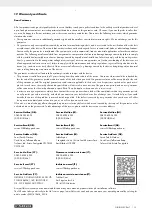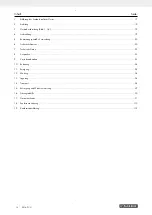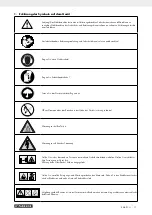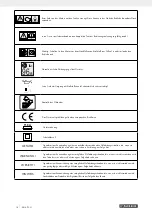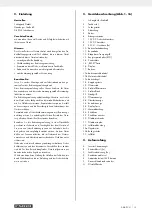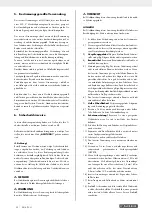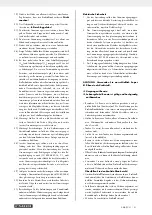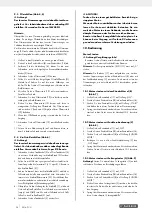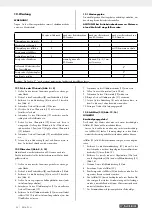
12
GB/IE/NI/CY/MT
12.8 Pairing the new radio remote control (C)
with the power generator/inverter (Fig. 3)
Note: The original radio remote control is al-
ready paired at the factory. A new radio remote
control from the spare parts shop must be paired
again. Pairing is not necessary when replacing
the battery!
1. Insert the ignition key (B) into the ignition lock (14).
2. Turn the ignition key (B) to the “STOP” position.
3. Set the fuel valve (11) to the “OFF” position.
4. Remove the battery compartment cover (10) by unscrew-
ing the two screws with the Phillips screwdriver (F) pro-
vided.
5. Press and hold down the pairing button (18).
6. Turn the ignition key (B) to the “RUN/REMOTE” position.
7. Now press the “ON” button on the radio remote control
(C) for 2 seconds and then the “OFF” button for 1 second.
8. Release the pairing button (18).
9. Turn the ignition key (B) to the “STOP” position.
10. Turn the ignition key (B) to the “RUN/REMOTE” position.
11. Start the engine with the radio remote control (C) as de-
scribed in section 10.2.
12. If pairing the radio remote control (C) with the device did
not work, repeat the procedure.
Please provide the following information in the
event of any enquiries:
• Machine data - type plate
• Engine data - type plate
Important note in the case of repairs:
For return delivery of the device for repair, please ensure for
safety reasons that it is free of oil and fuel when it is sent to
the service centre.
12.9 Ordering spare parts
Please provide the following information when ordering spare
parts:
• Device type
• Device article number
Service information
Note that the following parts on this device are subject to
natural or usage-related wear, or that the following parts are
required as consumables.
Wearing parts*: Spark plug, air filter
* may not be included in the scope of delivery!
Spare parts
:
Radio remote control - article no.:
7906200701
Radio remote control battery type:
CR1620
13. Storage
m
DANGER!
Risk of fire and explosion!
Storing the product near potential sources of ignition can result
in a fire or an explosion. This can lead to severe burns or death.
- Eliminate possible sources of ignition, such as furnaces, hot
water boilers with gas, gas dryers, etc.
NOTE!
Risk of damage!
If the product is not stored properly, the engine can be dam-
aged.
- Store the product protected against dirt, dust and moisture.
13.1 Preparation for storage
1. Empty the fuel tank (21) using a petrol extraction pump
(see section 13.3).
Warning:
Do not remove the petrol in enclosed spac-
es, near fire or when smoking. Petrol fumes can cause
explosions and fire.
2. Carry out an oil change (see section 12.3).
3. To do so, remove the used engine oil from a warm engine
and refill with fresh oil.
4. Remove the spark plug (28).
5. Fill approx. 20 ml of oil into the cylinder with oil filler
bottle (G) provided.
6. Pull the pull starter (3) slowly so that the oil protects the
inside of the cylinder.
7. Screw the spark plug (28) back in.
8. The ignition key (B) must always be removed from the
ignition lock (14) and stored securely to prevent unau-
thorised or improper use by children and other persons.
9. When the device is taken out of service for an extended
period of time, before starting work on or near electrical
components, disconnect the battery connection cable
(17a) from the engine connection cable (17b). We rec-
ommend removing the battery (17) and storing it fully
charged in a dry and locked room.
10. Store the device in a well-ventilated place or area.
13.2 Removing the battery (17) (Fig. 1, 3)
1. Remove the battery compartment cover (10) by unscrewing
the two screws with the Phillips screwdriver (F) provided.
2. Disconnect the battery connection cable (17a) and the
engine connection cable (17b).
3. Then loosen the two screws (16b) of the battery bracket
(17c) with the Phillips screwdriver (F).
4. Remove the battery (17).
5. Pull the protective caps off both poles of the battery (17).
6. Remove the two pole cables from the battery (17) with the
enclosed Phillips screwdriver (F).
Ensure that batteries are secured against unauthorised use
(e.g. by children).
Charge the battery (17) during the winter 1-2
times to ensure that the full charging capacity is
maintained. Incorrect storage can damage the
battery (17). In this case, the warranty is void.
13.3 Drain petrol with a petrol extraction pump
(Fig. 13)
In the case of storage over a longer period of time, the petrol
must be drained.
1. Hold a collection container under the hose of the petrol
extraction pump (not included in the scope of delivery).
2. Unscrew the fuel filler cap (2). The fuel filler cap (2) is
connected to an anti-loss device in the fuel tank (21) and
thus cannot fall off.
3. Remove the fuel filter insert (20).
Summary of Contents for PISE 3400 A1
Page 3: ...1 4 3 1 2 5 7 8 9 10 11 13 14 15 16 12 6 2 A B C D E F G...
Page 4: ...5 19 4 B 4 4 B 7 11 B 6 21 2 20 22 8 11 B 3 B 17b 17a 17 10 17c 18...
Page 5: ...9 3 11 B 10 11 B 13 28 29 12 27 Low Oil Overload Disp 11 23 24 25 26 14 28...
Page 6: ...16 33 32 15 30 31 32b 32a...
Page 117: ...111 18 18 18 18 18 18 18 18 18 18 18 18 18 18 18 18 18 18 18 18 18 18 18...
Page 119: ......

